After a long exam period and survey school, I was feeling the symptoms of MDD, mountain deficit disorder. I would constantly read the VOC message board, look at the weather forecast, map dream, without getting in the mountains. One way to treat a severe case of mountain deficit disorder is to go and do the Spearhead traverse, and climb peaks along the way. I hear Pete Hudson uses a similar treatment method for sufferers of HeCB, Habitus extrenus Columbius Britanicus or HaO, Habitus ad Onterriblus. My treatment required a slow and heavy traverse, instead of a fast and light Spearhead in a day kinda thing. Most people do it the latter way, but there are some really nice peaks they miss out on along the way.
May 14
Matt Gunn, Mike McClure and I left Vancouver in the afternoon to catch a lift up to the top of Blackcomb. This was quite a stressful order of events, starting with me finishing a morning exam, Matt picking me up, burning rubber along the Sea to Sky to get to Blackcomb, and rushing through the tickets place to catch the lifts up. We had a bit of extra work to do, as the upper lifts were closed due to high avalanche danger. It had rained in the morning, and the warm afternoon temperatures were leading to natural avalanche activity. We asked one of the patrollers what he thought of the temperatures, and he suggested there wouldn’t be any overnight crust recovery at all.
The trip had an ominous beginning. Just as I was about to traverse across the Blackcomb glacier, my ski pole broke. Fortunately these weren’t my pink ski poles, which are solid and not flimsy like these ones. It didn’t take a lot of pressure for the plastic locking mechanism between the poles to snap off. Fortunately there was a duct tape already on these poles, so I wrapped the pole a few times and hoped for the best. Earlier at the parking lot, Matt convinced me to try out these Komperdell 3-section poles instead, claiming they were lighter and looked better. The worst thing about the poles was the anti-shock mechanism, it really didn’t help on snow. I think I’ll stick to solid poles from now on.
We descended from the east col in a whiteout, and decided to camp near some flat rocks. Shortly after, the clouds disappeared, and I was feeling pretty happy that we were out in the mountains.
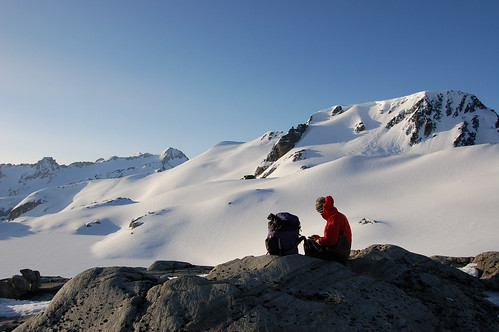
We were hoping for a solid overnight crust recovery, otherwise things could get really sketchy on slushy unfrozen slopes. Wondering about the amount of overnight freezing would become a common, somewhat stressful theme of the trip. Tonight I predicted a 70% chance of crust recovery, whereas the other two were more pessimistic with low estimates of 40%.
May 15
Despite a forecast 4000m freezing level, the snow did firm up. It was difficult to commit ourselves to the traverse, knowing the possibility of a lack of overnight crust recovery. We had six days of food, so we knew we could just travel in the morning, and chill out (fry our brains out in this case) with a book for the rest of afternoon.
It was important to wake up early to take advantage of the cooler weather. The theme for trip was to follow the standard route, while taking lots of side trips to climb peaks. It was really nice to take a break from the heavy pack aka the motherload or pig as we would call it, and climb a peak with a tiny pack instead. We skipped Decker, but decided to ski off the east face of Trorey. It was really nice, about 40 deg at the top, and the snow was just past corn on the way down. I’m not sure if it was just my lack of fitness from not really skiing in over two months, the heavy pack, or the warm sun, but the climb up to the Tremor-Shudder col was really tiring. Originally Matt wanted to ski the steep gnar off all the peaks, but the conditions weren’t looking so favourable. The north face of Tremor has a bergshrund crossing it, and the entire face was covered in icy avalanche debris. Not so mellow.
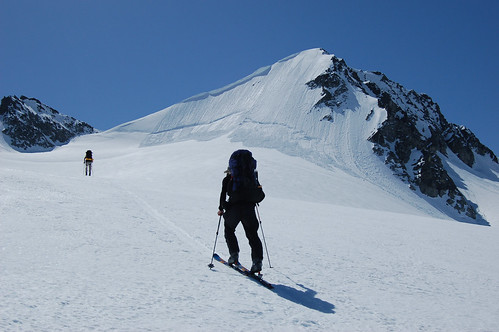
Once at the col, we skied up the east ridge of Tremor and had some slushy turns on the way down.

Next we climbed up Shudder Mountain via the south face from the platform glacier. This was fairly straightforward, and not really worth mentioning. We camped at the Quiver-Ripsaw col that night. After dropping the packs and setting up the tents, Matt and I went off to climb Quiver, and Ripsaw north.
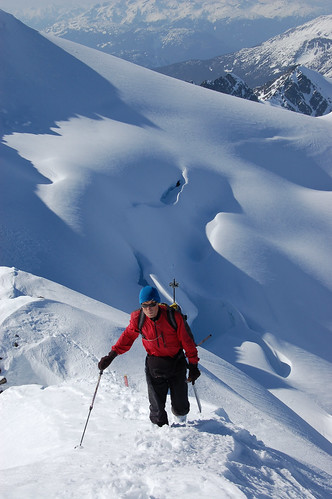
Matt was really happy when he got to the top of Quiver, as that completed the Fairley’s alphabet for him. I’m still missing three letters. The fifth peak of the day was Ripsaw north, mostly just a snow bump, but the evening views from it were quite nice.

The actual Ripsaw peak is further south, and that ascent involves a snow ramp above cliffs. It was suppose to be just a few hours of travel today, but I guess the conditions were better than expected and we managed to get in five peaks.
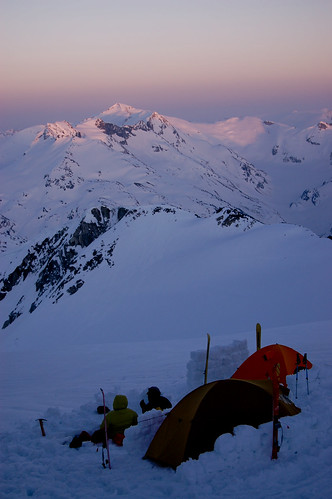
May 16
Overnight crust recovery happened again! The first thing to do in the morning was to traverse the Ripsaw glacier, where somebody had fallen into the bergshrund several weeks ago. Matt pointed out that he didn’t see these slots several weeks ago, and things were opening up really fast. The morning objective was Macbeth. We climbed up to the Macbeth-Ripsaw col, and skied up the north face. Ski crampons were really useful here, things were icy, and if you fell, the huge crevasses below would eat you up. Apparently the Curtain glacier coming off Macbeth is a really good ski run, but it was looking really gnarly today. We brought along harnesses and ropes on this trip, and it came handy for the belay across the bergshrund on the face.
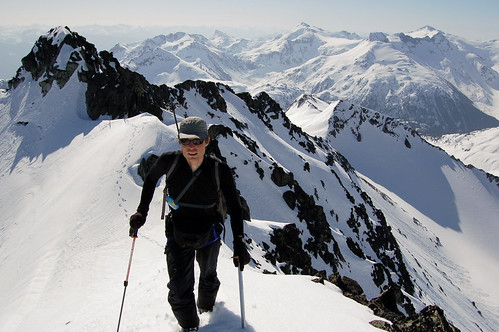
For the descent, we traversed the north face below the false summit, and then skied off the southeast face. This would be a less exposed ascent route.
From Couloir ridge onwards, things started to warm up quickly. Notably, naturals were occurring wherever rocks were present. When I took off my ski to get around a rocky section on ridge leading to Iago glacier, the weight of the ski on the snow triggered the isothermal slush and the little point release slowly grew larger. There was evidence of big and small avalanches on all aspects, generally from cornice failures, and start zones near rocks. The snow started to get really gross on the Iago glacier, and we were happy to make it to the col east of Iago by noon. Thoughts of climbing Iago quickly disappeared as we scoped the two options to the top: a ridge covered by a sagging cornice, or a gnarly face with snow periodically sluffing down it. Instead, we chose to seek shelter from the sun, and had an afternoon chill out time with our books.

Matt’s watch measured 40C in the sun at one point. Not sure if that’s accurate, but it was definitely hot. That evening we climbed a nearby bump to enjoy the sunset views over the Mcbride range and camp.
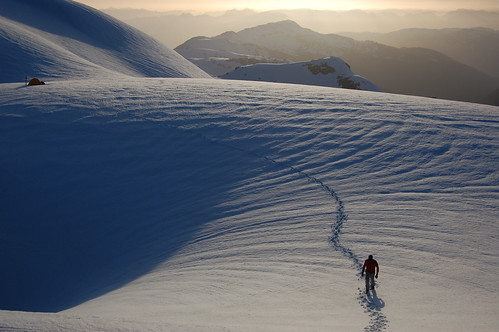
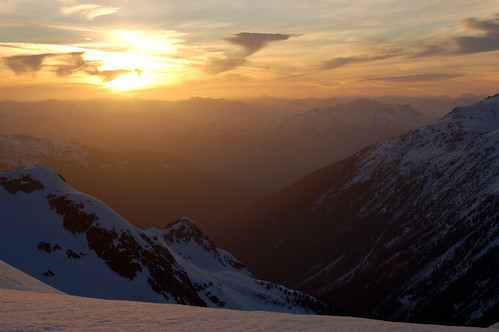
May 17
The wind picked up overnight, and the barometer had dropped 5 millibars overnight. We sensed an urgency to get a move on before the weather moved in. The morning started with a stiff wakeup call, an early wakeup of 5am, and the steep descent down to the Diavolo glacier in breakable crust. We all agreed that it was some of the worse skiing we had experienced. If only powder came in mid-May.
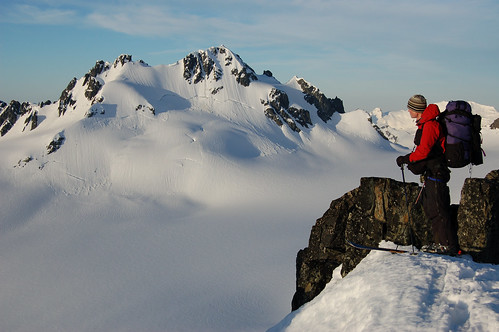
Soon it was time to leave the heavy pigs on the glacier, and take the daypacks to go and climb another peak, this time the south face of Fitzsimmons. The route goes up the gully between the two peaks of Fitzsimmons, and veers climbers right into a narrower gully when steepens to 48° snow. Beyond that, it was just scrambling on lower angle loose rock and snow to get to the summit.
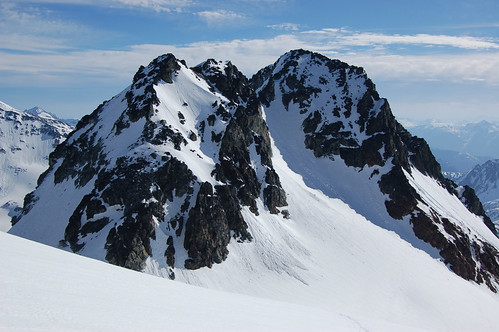
During the planning of this trip, Matt was pretty keen to ski all the steep faces, Fitzsimmons included. But it seemed the season for steep skiing on the Spearhead was over, as most of the snow was sliding off and the bergshrunds were all wide open. Plus I had these broken poles.
I felt compelled to climb Benvolio, as it was so close to the route, so the other two followed me. Some pretty turns were had on the way down from Benvolio.

Photo by Matt Gunn.
We also climbed Overlord, but the snow was really sticky there, and more isothermal due to warming of rocks. The route ahead was the final crux in the trip. We were worried about traversing the east side of Overlord to get to the north side, since the sun would have been baking that aspect all day. We considered an alternate route of going south of Overlord and over the Refuse pinnacle, but soon we realized any slides on that south facing aspect would just be a death trap into Refuse Creek. No wonder it’s not included as an alternate route in Baldwin’s map.
We did rope up to get around part of Overlord though. We were somewhat concerned of the warm temperatures causing snow bridges to weaken rapidly. It turned out the snow going around Overlord was actually not too bad, and soon we got to the high col leading down to the death zone of cornices hanging off Overlord. Skiing roped up isn’t fun though. We were really happy by the time we got across that slope, littered with massive chunks of cornices across old ski tracks.

I thought about climbing Whirlwind too, but the snow was getting soft, so instead we enjoyed some turns down towards Russet lake, though a tad heavy and sticky. We decided to go out Singing Pass instead of slogging all the way towards Whistler. The bike park was open, there was a chance that we could download, but it would still mean skiing over the Musical Bumps and over Whistler in the hot sun. The shade in Singing Pass was way much nicer. Since Wed, we hadn’t seen anybody else on the Spearhead range. Somewhere along the trail, we meet a group of people headed towards Russet Lake, in hopes of doing the Spearhead traverse. It took us four hours to ski out from Singing Pass, this would have been faster if we skied some more sections instead of just postholing it.
It felt pretty weird walking into Whistler village on a sunny Saturday afternoon. I highly recommend spending a few days on the Spearhead range, and climbing some of the peaks along the way instead of just blazing through the route. Out of the nine peaks we climbed, I think Quiver (nice mellow snow ridge), Macbeth (great views), and Fitzsimmons (somewhat sporty) were the best. Also, be wary of any ski poles that Matt might give you =)